Alabama Emergency Vehicle Light State Statutes
Alabama Emergency Vehicle Light Laws (2026 Statutes)
 Alabama law strictly defines how emergency vehicle warning lights and sirens must be used on public roads. These rules are important not only for law enforcement officers, firefighters, EMTs, and tow operators, but also for everyday drivers who share the road with them. The foundation of these requirements comes from Code of Alabama §32-1-1.1 (definition of “authorized emergency vehicle”) and §32-5A-115 (use of signals and right-of-way).
Alabama law strictly defines how emergency vehicle warning lights and sirens must be used on public roads. These rules are important not only for law enforcement officers, firefighters, EMTs, and tow operators, but also for everyday drivers who share the road with them. The foundation of these requirements comes from Code of Alabama §32-1-1.1 (definition of “authorized emergency vehicle”) and §32-5A-115 (use of signals and right-of-way).
In practice, the law draws a sharp distinction between vehicles that are granted right of way authority and those that may only display amber and yellow warning lights. For example, blue lights are reserved exclusively for police vehicles, while red lights are required for fire apparatus and ambulances. Tow trucks, construction fleets, and utility vehicles may use amber lights when designated by the proper authority, but these lights are treated only as warnings. They do not compel other motorists to yield. To lawfully request right of way, an authorized emergency vehicle must display a lighted lamp visible from at least 500 feet and sound an audible signal such as a siren, whistle, or bell.
For agencies, volunteers, and contractors, these statutes directly shape which products can be installed on vehicles. Our team has mapped Alabama’s laws to the right categories of equipment — from LED Warning Lights to Mini Light Bars. This page walks through each profession police, fire, EMS, volunteers, tow, construction, utility, pilot, escort, and security. Showing what colors are legally allowed, what signals are required, and how compliant setups are achieved in Alabama.
Police Lights in Alabama
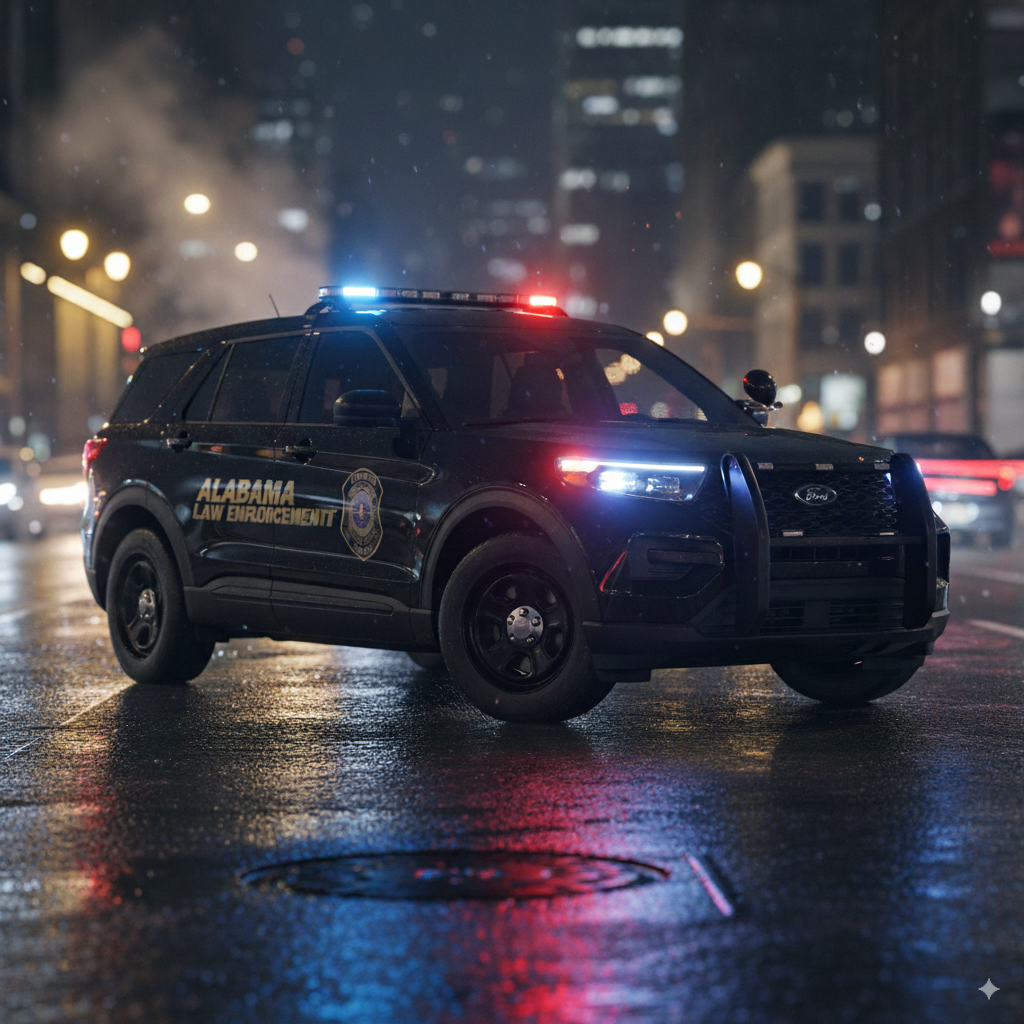
Statutory Rules
In Alabama, blue lights are reserved exclusively for police vehicles, as defined in Code of Alabama §32-5A-115(c). Other than police, no public or private vehicle is legally permitted to display a blue warning light. Police may also use red lights, but blue remains the defining identifier of law enforcement. To lawfully request right of way, an officer must operate a lighted lamp visible from at least 500 feet and simultaneously sound an audible warning device such as a siren, whistle, or bell.
Practical Application
For marked patrol cars, visibility from every angle is critical. Full-size roof light bars provide maximum warning power on highways and urban streets. Supplementing them with LED Grille and Surface Mount Strobes ensures intersection clearing and 360° coverage. Unmarked units often choose Visor Lights or discreet hideaway strobes to maintain stealth while still meeting statutory compliance.
Operational Considerations
Sirens remain a legal requirement when invoking right of way. A compliant police light setup pairs audible warning with visual signals for maximum effectiveness. Alabama’s statutes make clear that lights alone do not grant authority; the audible warning is the second half of the legal trigger. Agencies should also review installation practices to ensure wiring, switch boxes, and controllers allow quick activation under stress.
Shop Police Equipment
For compliant setups, browse Police Lights and Police Sirens. These categories provide the full range of Alabama-compliant options for law enforcement.
Fire Truck Lights in Alabama
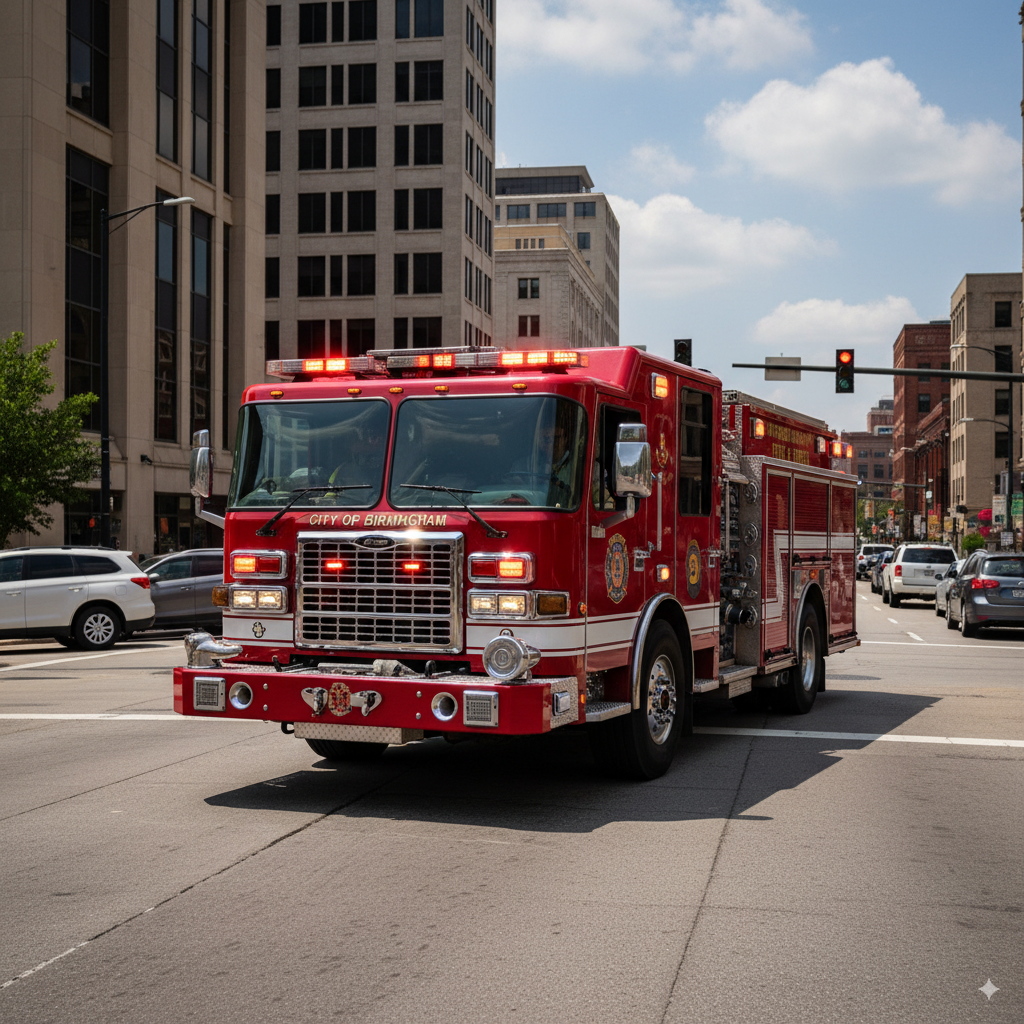
Statutory Rules
Under Alabama law, fire department vehicles are classified as “authorized emergency vehicles” under Code of Alabama §32-1-1.1 and regulated by §32-5A-115. These statutes require the use of red warning lights for fire apparatus when responding to calls. Unlike law enforcement, fire trucks are not permitted to use blue lighting, which is reserved exclusively for police. To lawfully request the right of way, a fire truck must display a lighted red lamp visible from 500 feet and simultaneously sound an audible signal such as a siren, exhaust whistle, or bell. These two components light and sound together establish the legal authority to proceed against normal traffic flow.
Practical Application
Fire trucks face unique challenges in visibility. Their large size provides elevation for roof-mounted full-size light bars, but due to intersections, alleys, and crowded roadways, supplemental lighting is often required. Adding perimeter strobes, LED Warning Lights , and side facing modules ensures 360° coverage. Scene lights and takedown/alley functions are also crucial for illuminating fire grounds and emergency response areas, enhancing firefighter safety during operations.
Operational Considerations
Because of their role in emergency response, fire vehicles must balance high visibility warning lighting with on scene utility. Controllers should allow for quick switching between response patterns (rapid flash) and scene operation (steady burn). Departments should also regularly test siren volume output to confirm compliance with Alabama’s audible requirement, especially in urban areas where ambient noise can drown out weaker sirens.
Shop Fire Equipment
Departments and municipalities can outfit their fleets with Full Size Light Bars for primary warning, supplemented with directional and perimeter strobes for full coverage. These configurations ensure compliance with Alabama law while providing firefighters the visibility they need.
Volunteer Firefighter Lights in Alabama
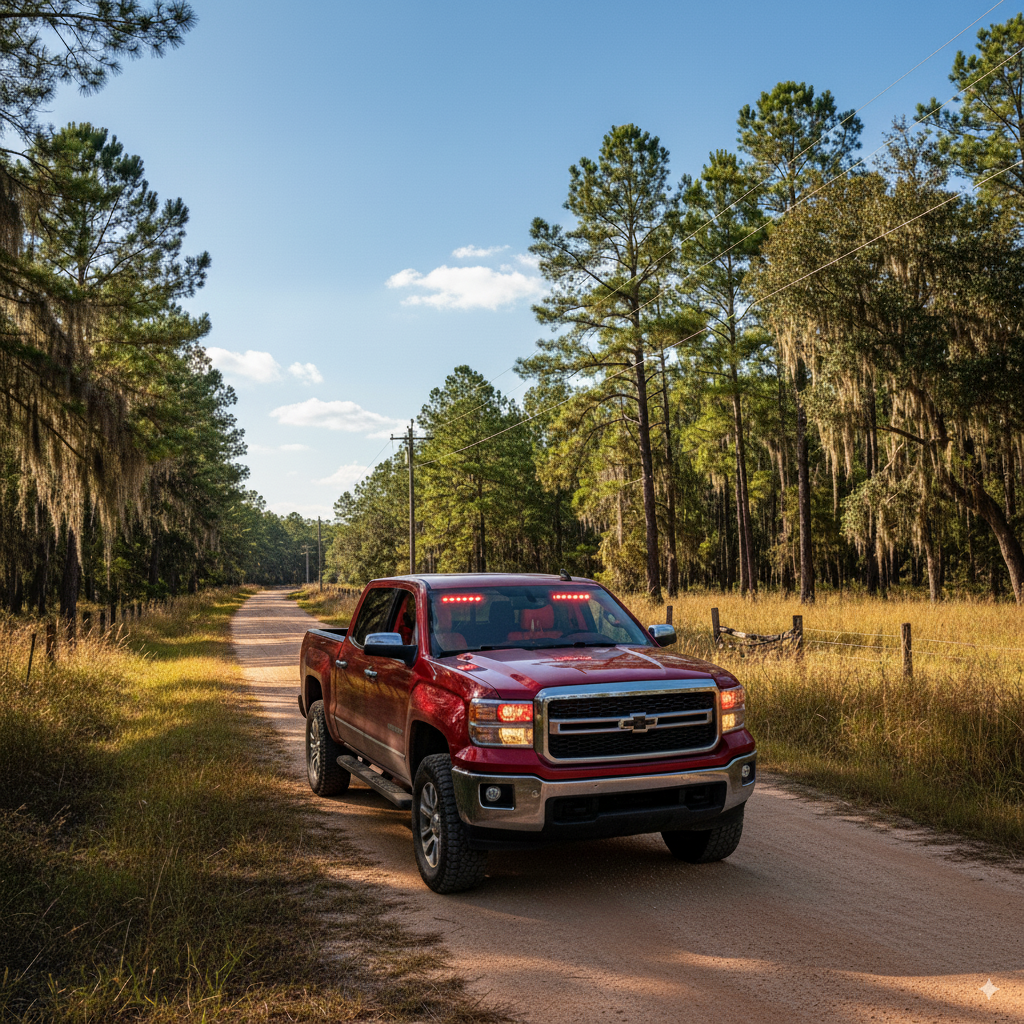
Statutory Rules
Volunteer firefighter vehicles, whether department owned or personally owned, fall under Alabama’s rules for “authorized emergency vehicles” when actively responding to an alarm. The controlling laws are Code of Alabama §32-1-1.1 and §32-5A-115. These statutes require red warning lights for fire service vehicles and specifically prohibit the use of blue lights, which are reserved for law enforcement only. To lawfully request right of way, a volunteer firefighter must operate both a lighted red lamp visible from at least 500 feet and an audible signal such as a siren, whistle, or bell. Without both signals, a responding vehicle is not legally entitled to right of way.
Practical Application
Volunteer firefighters often use their privately owned vehicles (POVs) for emergency response, especially in rural areas where department fleets are limited. These vehicles must comply with Alabama law and local department policy before warning equipment is installed. Common configurations include discreet Visor Lights , compact Mini Light Bars , or Hideaway Strobe Lights for headlight or taillight integration. These options provide strong visibility without altering the overall appearance of a POV when not responding.
Operational Considerations
Departments must authorize the use of warning lights by volunteers. Some agencies issue permits or written policies to confirm compliance. Volunteers should also train on safe activation, ensuring that red lights are only used during official responses and that sirens are always paired with lighting when claiming right of way. Improper or unauthorized use may create liability for both the individual and the department.
Shop Volunteer Firefighter Lighting and Sirens
We supply a full line of Volunteer Firefighter Lights and Sirens, designed for compliance with Alabama law while providing the discreet power volunteers need.
Ambulance Lights in Alabama
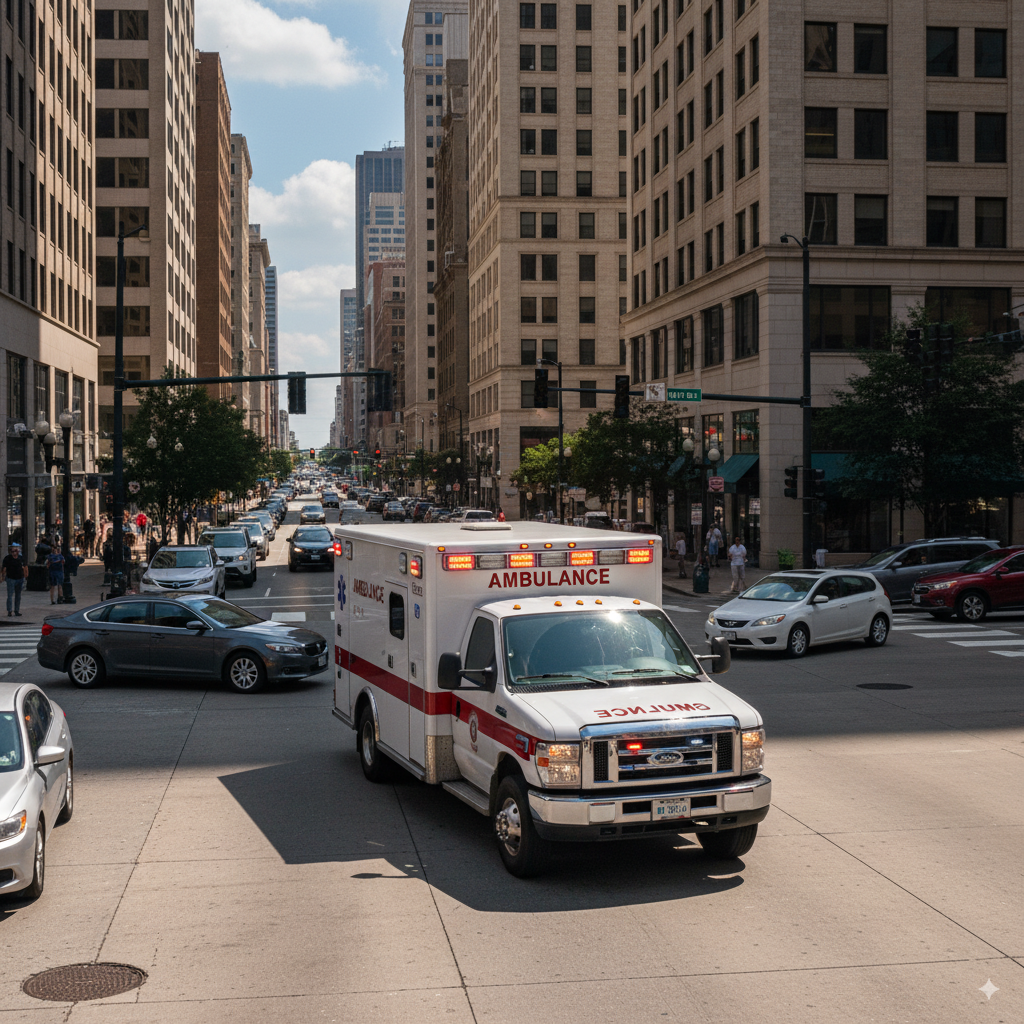
Statutory Rules
Ambulances in Alabama are explicitly included in the definition of “authorized emergency vehicles” under Code of Alabama §32-1-1.1, with operational requirements detailed in §32-5A-115. These vehicles must display red warning lights when responding to emergencies. Blue is prohibited, as it is reserved for police vehicles. Importantly, Alabama law requires that ambulances use both a lighted red lamp visible from 500 feet and an audible signal such as a siren, whistle, or bell when requesting right of way. Both components must be active for the ambulance to have legal authority to proceed through intersections or against the normal flow of traffic.
Practical Application
Ambulances face unique visibility and operational challenges. They must alert traffic ahead, behind, and at intersections while also ensuring safe loading and unloading of patients. Full size roof mounted LED light bars provide the primary warning, but they are often paired with rear facing directional sticks and LED Warning Lights on the vehicle perimeter. Side mounted strobe modules improve visibility during turns, and steady burn scene lights assist paramedics in providing care at night or in poor weather.
Operational Considerations
Integration between the ambulance’s siren system and its lighting controls is vital. Switch boxes and controllers should allow a single activation for both audible and visual signals to ensure statutory compliance during high pressure calls. Departments should also regularly test their sirens and ensure backup systems are functional in case of primary unit failure. Failure to activate both light and sound could create liability in traffic incidents.
Shop Ambulance Equipment
Agencies can build compliant setups with Full Size Light Bars , supplemented by rear directional lights and side strobes. These options meet Alabama’s requirements and enhance ambulance visibility for safer emergency response.
Tow Truck Lights in Alabama
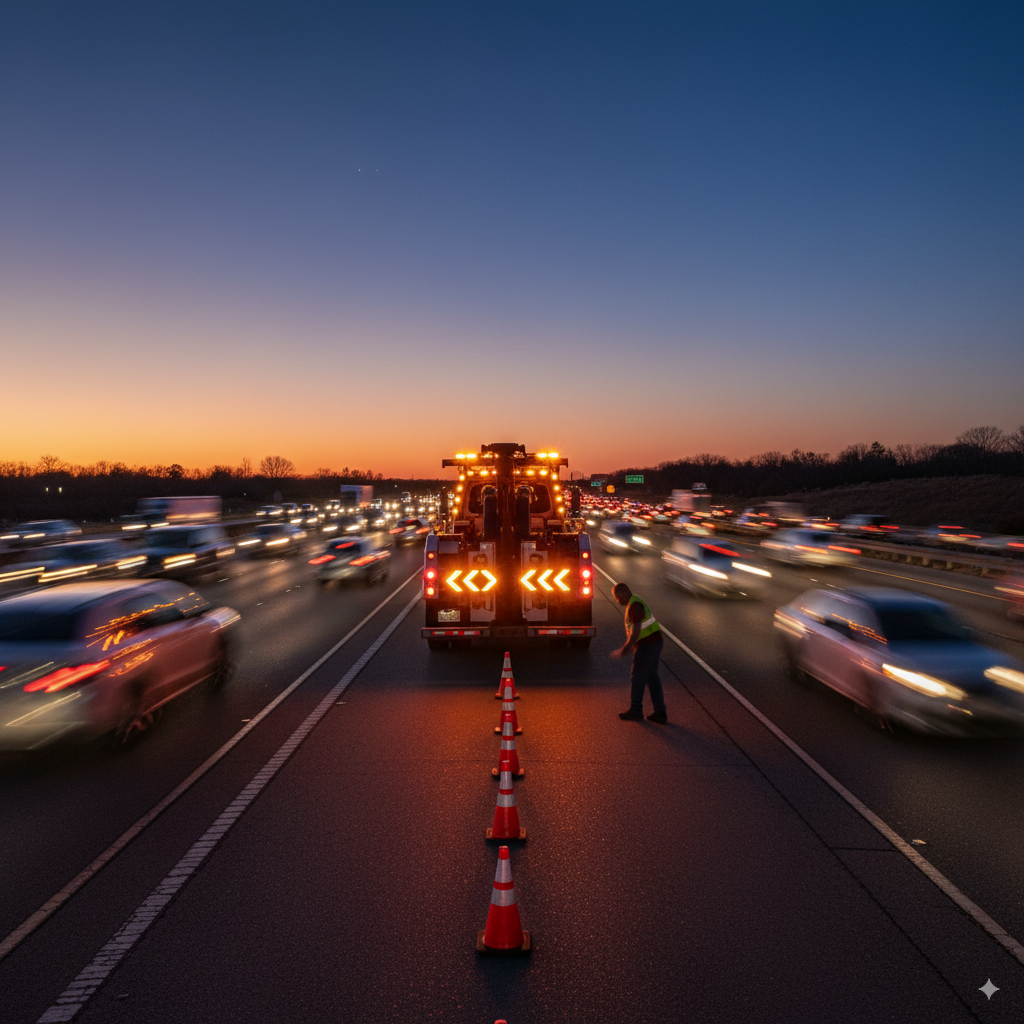
Statutory Rules
Tow trucks and wreckers in Alabama are not “authorized emergency vehicles” under Code of Alabama §32-1-1.1, but they may be designated to use amber or yellow warning lights when approved by competent authority such as the Secretary of ALEA or local police chiefs. Unlike red or blue lights, amber warning lights do not grant the operator the right of way. Under §32-5A-115, only emergency vehicles with both a lighted lamp and an audible siren may lawfully request other drivers to yield. For tow trucks, amber lighting functions solely as a cautionary signal, alerting surrounding traffic to a potential hazard on the roadway.
Practical Application
Tow operators often work in dangerous conditions along Alabama’s highways and rural roads, particularly at night or during inclement weather. To maximize safety, tow trucks should be equipped at a minimum with bright Magnetic Mini Light Bars, rear facing arrow sticks, and perimeter mounted LED Warning Lights. High mounted amber lights improve long distance visibility, while side strobes ensure approaching vehicles can see the operator when working outside the cab. Because amber does not demand right of way, these lights serve as critical safety devices that give motorists time to move over or slow down.
Operational Considerations
Alabama’s Move Over Act requires drivers to change lanes or slow when approaching a tow truck stopped roadside with its amber lights flashing. Operators should verify that their lighting packages comply with SAE and state safety standards, and that rearward lighting includes directional functionality to guide traffic around a stopped vehicle. Proper training in activating caution lights before exiting the truck further reduces risks.
Shop Tow Truck Equipment
For reliable amber solutions, browse Tow Truck Lights and LED Grille & Surface Mount Strobes. These products ensure compliance while providing maximum roadside visibility for Alabama operators.
Construction Vehicle Lights in Alabama

Statutory Rules
Construction vehicles operating on Alabama roads are not classified as “authorized emergency vehicles” under Code of Alabama §32-1-1.1. Instead, when designated by proper authority, they may display amber and yellow warning lights to alert surrounding motorists of potential hazards. These amber lights serve strictly as warnings and do not grant right of way. Only vehicles that display a red or blue light in combination with an audible signal, as outlined in §32-5A-115, may lawfully request other drivers to yield.
Practical Application
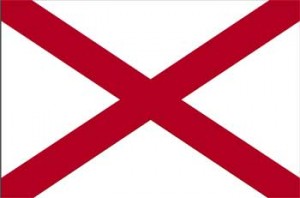 Construction fleets face significant risks on highways and local roads. Workers often operate near moving traffic, sometimes at night or in poor weather. High visibility lighting is critical for safety. Vehicles should be equipped with roof mounted Mini Light Bars , perimeter LED Strobe Lights, and rear facing arrow sticks to direct motorists safely around work zones. Scene lighting is equally important, ensuring crews have illumination to perform tasks after dark.
Construction fleets face significant risks on highways and local roads. Workers often operate near moving traffic, sometimes at night or in poor weather. High visibility lighting is critical for safety. Vehicles should be equipped with roof mounted Mini Light Bars , perimeter LED Strobe Lights, and rear facing arrow sticks to direct motorists safely around work zones. Scene lighting is equally important, ensuring crews have illumination to perform tasks after dark.
Operational Considerations
Even with amber lights, construction vehicles do not have traffic priority. This makes Alabama’s Move Over Act especially relevant. Motorists are required to reduce speed or change lanes when approaching construction vehicles displaying amber lights roadside. Fleet managers should ensure all vehicles meet SAE standards for warning equipment, and operators should receive training on activating caution, warning lighting whenever vehicles are moving slowly, stopped on the shoulder, or working in traffic areas. Proper placement of light bars and strobes can greatly reduce the risk of work zone accidents.
Shop Construction Equipment
Explore Construction Vehicle Lights and Full Size Light Bars to build safer, more visible fleets that comply with Alabama’s rules and keep crews protected.
Utility Vehicle Lights in Alabama
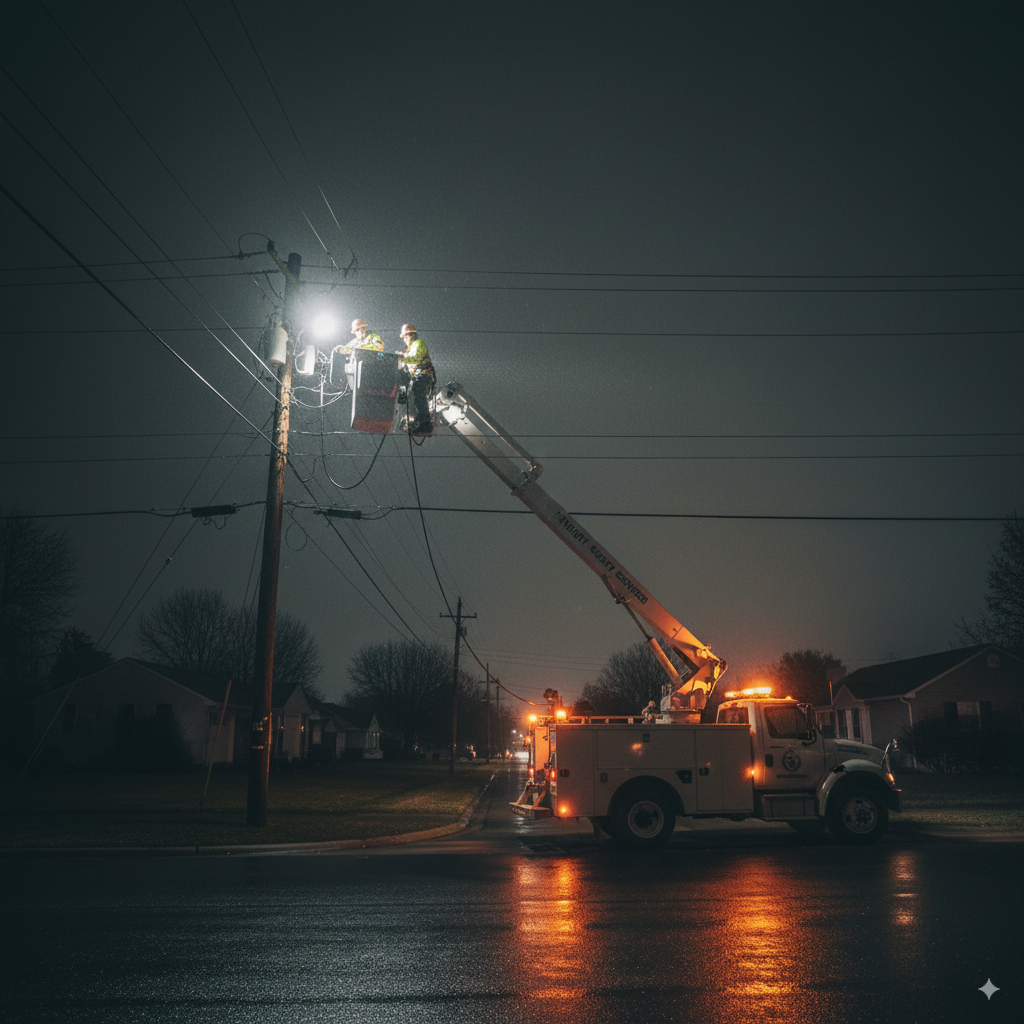
Statutory Rules
Utility fleets, such as power companies, telecommunications trucks, and municipal service vehicles, are not classified as “authorized emergency vehicles” under Code of Alabama §32-1-1.1. However, when designated by the Secretary of ALEA or a municipal police chief, they may operate amber/yellow warning lights under Alabama law. These lights are strictly for warning purposes and do not grant right of way. As emphasized in §32-5A-115, only vehicles displaying a red or blue lamp combined with an audible siren may lawfully demand other drivers to yield. Utility vehicles must therefore rely on amber lighting solely as a safety precaution.
Practical Application
Utility trucks frequently work in hazardous roadside environments, such as restoring power during storms, repairing gas lines, or servicing communication equipment. To protect workers and ensure motorist awareness, vehicles should be outfitted with high mounted amber Full Size Light Bar , perimeter strobes, and LED Grille & Surface-Mount Strobes. These setups provide 360° visibility and alert passing motorists well in advance. Scene lighting is equally vital, allowing crews to safely perform utility repairs at night or in inclement weather.
Operational Considerations
While amber lights help alert drivers, they do not carry legal authority to control traffic. This makes Alabama’s Move Over Act critical to utility operations, as drivers are required to change lanes or slow down when approaching roadside work vehicles with lights active. Fleet managers should ensure lights are SAE-compliant, positioned for maximum visibility, and wired for easy activation by operators. Regular training should reinforce the importance of activating amber lights any time vehicles stop or slow down in travel lanes.
Shop Utility Vehicle Equipment
For complete safety solutions, utility companies can explore Utility Vehicle Lights, ensuring compliance and worker protection in Alabama.
Pilot/Escort Vehicle Lights in Alabama
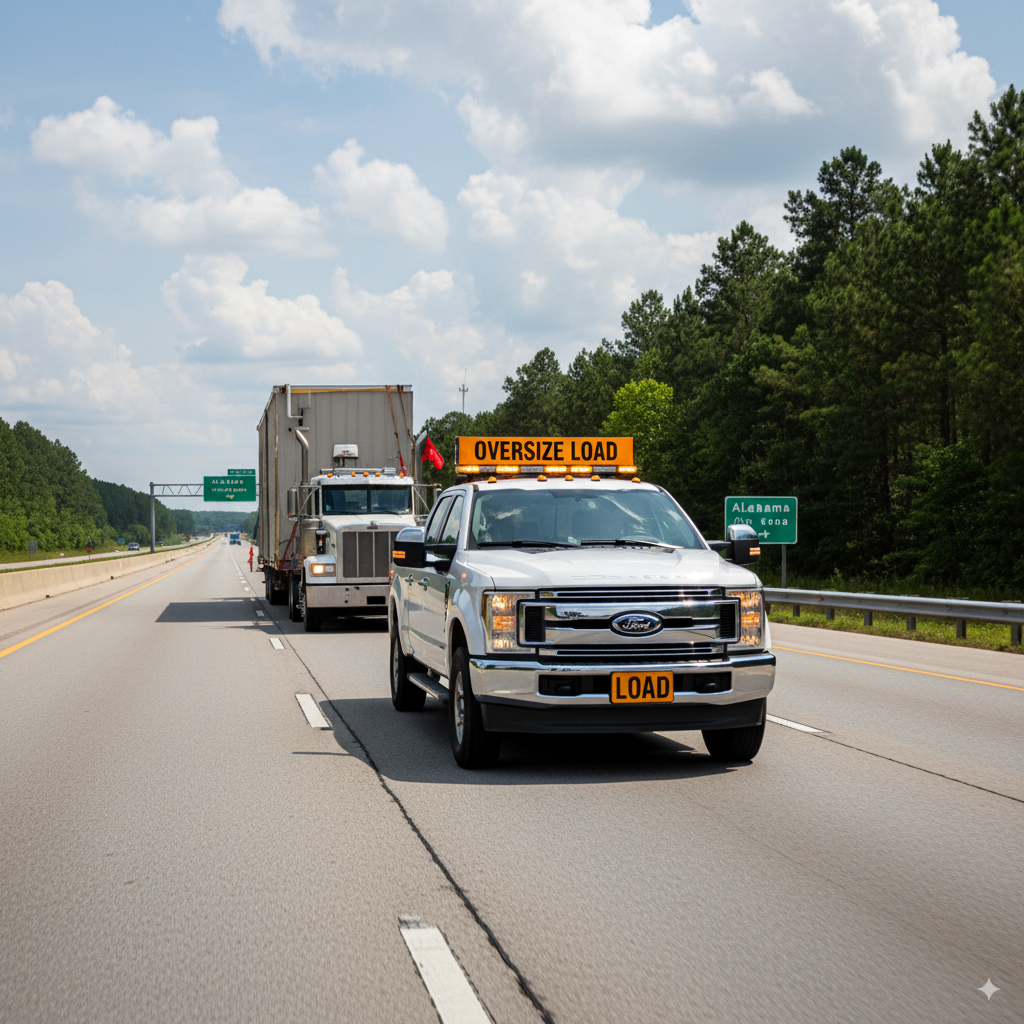
Statutory Rules
Pilot and escort vehicles that guide oversize or overweight loads on Alabama roads fall under the category of caution vehicles, not “authorized emergency vehicles.” Under Code of Alabama §32-1-1.1, they are not given right of way authority, but they may be designated by ALEA or local law enforcement to operate amber/yellow warning lights. These lights serve to warn surrounding motorists of approaching oversized loads but do not, by themselves, require other drivers to yield. As reinforced in §32-5A-115, only vehicles equipped with a red or blue lamp and an audible siren may legally demand right-of-way.
Practical Application
Escort vehicles have the critical job of protecting oversized transports, which often move at slower speeds and require additional road space for turns. To maximize visibility, pilot cars should use roof mounted Mini Light Bars with bright amber strobes, as well as rear facing arrow sticks to direct trailing traffic. “OVERSIZE LOAD” signage is typically required and should be mounted prominently at both front and rear. Pairing signage with lighting ensures maximum driver awareness, especially during dusk, night operations, or inclement weather.
Operational Considerations
Operators must follow strict DOT and ALEA regulations, including route permits and designated travel hours. Escort drivers are also responsible for maintaining clear communication with both the transport vehicle and law enforcement escorts when present. Lighting should remain active throughout the journey to warn motorists approaching from any direction. While amber lights do not grant legal right of way, Alabama’s Move Over Act encourages motorists to slow or change lanes when passing escort vehicles with lights active, adding an extra layer of safety.
Shop Pilot Escort Vehicle Equipment
Escort operators can enhance safety and compliance with Pilot and Escort Vehicle Lights and Full Size Light Bars, both offering high-visibility amber lighting ideal for oversized load escorts.
Security Vehicle Lights in Alabama
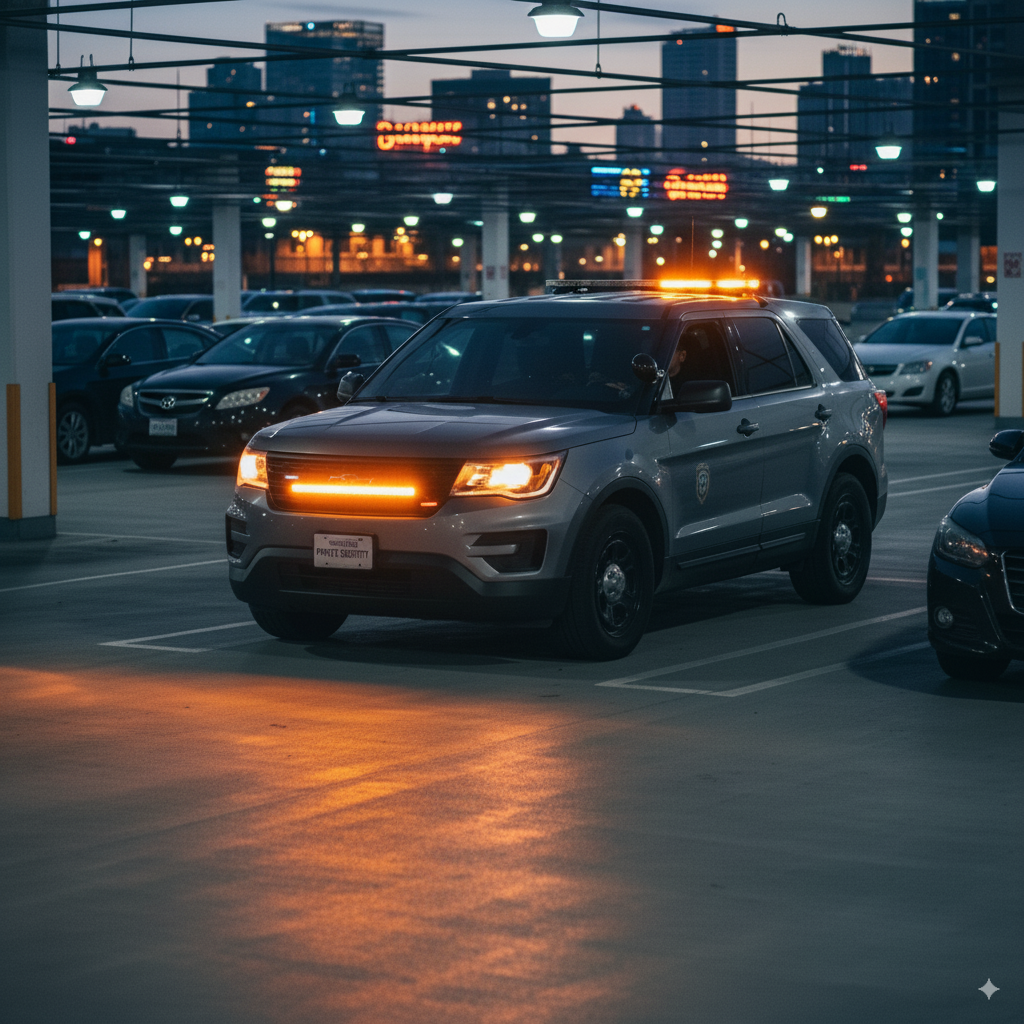
Statutory Rules
Private security vehicles in Alabama are not included in the statutory definition of “authorized emergency vehicles” under Code of Alabama §32-1-1.1. As a result, they are not permitted to use red or blue lights. Blue lighting remains restricted to police, and red is reserved for fire and ambulance use. When approved by local authorities, however, security companies may equip their vehicles with amber/yellow warning lights. These lights serve only as a warning to enhance visibility and do not carry right of way authority under §32-5A-115. Any use of lights beyond amber may constitute impersonation of law enforcement and result in penalties.
Practical Application
Security fleets often operate in environments such as college campuses, shopping centers, industrial parks, and gated communities. The primary purpose of lighting on these vehicles is deterrence and safety visibility, not traffic control. Amber Visor Lights and low profile LED Warning Lights mounted discreetly on grilles or rear decks provide strong caution signals while avoiding any resemblance to law enforcement setups. Mini light bars with amber only patterns are also effective for parking lot patrols or when stopped at incident scenes.
Operational Considerations
Because security vehicles are not emergency responders, lighting should be deployed conservatively to avoid public confusion. Operators must remember that amber lights do not authorize them to disregard traffic laws or request right of way. Training policies should clearly instruct security personnel on when and how to activate lights, such as when securing a scene, directing private property traffic, or warning of hazards. Overuse or misuse of lighting could reduce its deterrent effect and potentially create liability for impersonation.
Shop Security Vehicle Equipment
Private agencies can maintain compliance and increase safety with amber-only Hideaway Strobe Lights and compact Mini Light Bars , both designed to provide visibility without conflicting with Alabama law.
Courtesy vs. Emergency Lights in Alabama
Statutory Rules
Alabama law makes a clear distinction between authorized emergency vehicles and vehicles that only use warning caution lighting. Under Code of Alabama §32-5A-115, an emergency vehicle must display both a lighted lamp (red or blue, depending on vehicle type) and an audible signal (siren, whistle, or bell) in order to lawfully claim the right of way. Without both signals active, even an authorized emergency vehicle cannot demand that other motorists yield. Amber/yellow lights, which may be authorized for vehicles such as tow trucks, construction fleets, utility trucks, or pilot/escort vehicles, serve only as caution lights. They do not carry the authority to override traffic laws or compel drivers to stop or move over, although Alabama’s Move Over Act does require drivers to use extra caution and change lanes when passing roadside vehicles displaying amber lights.
Practical Application
This distinction matters for every operator. A police cruiser running only red lights without a siren cannot demand the same right of way as one operating both signals. Likewise, an ambulance using lights but no audible signal may create confusion and potential liability in the event of an accident. For non emergency vehicles like tow trucks, amber lights should be viewed as a driver safety tool, not an authority mechanism. They alert motorists to potential hazards but do not change the rules of the road.
Operational Considerations
Drivers and fleet managers must train operators to understand this distinction. Emergency responders should ensure their lighting and siren systems are always functional and activated together during responses. Non emergency operators should use amber lights whenever stopped roadside, in work zones, or when performing escort duties, but must never assume traffic priority. Clear policies help reduce accidents, protect workers, and keep fleets compliant with Alabama law.
Shop Compliance-Ready Equipment
Agencies and contractors alike can stay compliant with LED Warning Lights , Visor Lights , and Police Sirens , ensuring that equipment is legally configured for either courtesy or emergency use in Alabama.
Siren Laws in Alabama
Under Code of Alabama §32-5A-115, no vehicle may legally request the right-of-way without both a lighted lamp and an audible warning device such as a police siren, whistle, or bell.
Police, fire, and EMS vehicles must activate both signals simultaneously during emergency response. Tow trucks, construction, and utility vehicles may not use sirens and therefore cannot claim right-of-way.
Failure to use an audible warning when required can expose operators and agencies to liability under Alabama traffic law.
Compliance Checklist for Alabama Emergency Vehicle Lighting
Ensuring compliance with Alabama’s emergency vehicle lighting laws requires more than simply installing warning lights. Fleet managers, volunteers, and contractors should use this checklist to confirm that their vehicles meet state standards while maximizing safety.
- Confirm Vehicle Classification
Check whether your vehicle qualifies as an “authorized emergency vehicle” under §32-1-1.1. Police, fire, and ambulances fall into this category, while tow trucks, construction, utility, and escort vehicles typically do not.
- Match Light Color to Role
- Police: Red and blue (blue reserved exclusively for law enforcement)
- Fire/EMS: Red lights only.
- Non-emergency fleets (tow, construction, utility, pilot/escort, security): Amber/yellow caution lights.
- Right of Way Requirements
Only authorized emergency vehicles may claim right of way, and only when operating both a compliant lamp and an audible signal (§32-5A-115).
- Equipment Certification
Select SAE rated lighting products to ensure legal compliance and reliability.
- Training and Policy
Ensure operators know when lights may be used legally and how to pair them with sirens if required.
- Product Selection
Equip vehicles with approved solutions like Full Size Light Bars or Hideaway Strobe Lights to meet statutory and operational needs.
Statutes & Official Guidance
Alabama’s lighting laws for emergency and caution vehicles are built around two key statutes, supported by official guidance from the Alabama Law Enforcement Agency (ALEA). These sources define which vehicles qualify as “authorized emergency vehicles,” what colors they may display, and when other motorists are required to yield.
Code of Alabama §32-1-1.1 – Definitions
This section defines “authorized emergency vehicles” to include police, fire, and ambulances, as well as other vehicles designated by the Secretary of ALEA or local authorities. It is the foundation for determining which fleets qualify for red lighting and right-of-way privileges. Alabama Code Title 32, Chapter 1 (includes §32-1-1.1 definitions)
Code of Alabama §32-5A-115 – Use of Signals and Right-of-Way
This statute governs how emergency vehicles operate lights and sirens. It requires both a lighted lamp visible from 500 feet and an audible signal to lawfully request right of way. It also establishes that blue lights are reserved for police, while red applies to other emergency vehicles. Alabama Code §32-5A-115 — Signals on Emergency Vehicles
ALEA Guidance
ALEA publishes operator guidance for volunteer firefighters and first responders, confirming that amber/yellow lights serve only as warning and caution and do not create right of way. ALEA also provides information on Alabama’s Move Over Act, which requires motorists to slow or change lanes when approaching roadside vehicles with lights flashing.
For the most current legal text, operators should review the Alabama Code online and ALEA’s public resources before outfitting vehicles. ALEA Volunteer First-Responder Vehicle Operators (official guidance)
For more information about what lights may be available to you, we suggest calling your State Highway Patrol office at: 614-466-2660
*Please note that the above contact information is what we are currently able to find and the numbers may have changed since this listing.
Frequently Asked Questions (FAQ)
Can volunteer firefighters use blue lights in Alabama?
No. Blue lighting is reserved exclusively for police under §32-5A-115. Volunteer firefighters may use red lights when authorized by their department, but never blue. For discreet and compliant setups, see Volunteer Firefighter Lights.
Do tow trucks in Alabama have right-of-way when using amber lights?
No. Amber/yellow lights on tow trucks are treated as caution only. They do not grant right-of-way; motorists are encouraged under Alabama’s Move Over Act to slow or change lanes when passing.
Are both lights and sirens required for emergency vehicles to claim right-of-way?
Yes. Under §32-5A-115, authorized emergency vehicles must use both a lighted lamp and an audible siren, whistle, or bell when requesting right-of-way. Using only lights does not meet the statutory requirement.
What color lights can private security vehicles use in Alabama?
Private security vehicles may be authorized to use amber caution lights but cannot display red or blue. Using restricted colors may constitute impersonation of law enforcement.
Do construction vehicles qualify as emergency vehicles in Alabama?
No. Construction vehicles may be authorized to display amber/yellow lights but are not considered emergency vehicles under §32-1-1.1. Their lights function only as warnings to alert motorists of work zones.
Are ambulance operators required to use sirens at all times?
Ambulances must use both red lights and an audible signal when requesting right-of-way. However, agencies may set policies on when sirens are engaged for patient comfort, but legally, the siren is required for traffic control.
Do utility trucks fall under Alabama’s Move Over Act protections?
Yes. While utility vehicles cannot claim right-of-way, the Move Over Act requires motorists to slow down or change lanes when passing roadside service or utility trucks with amber lights flashing.
Can oversized load escorts use red or blue lights?
No. Pilot/escort vehicles are limited to amber caution lights with appropriate signage. Red and blue remain reserved for emergency vehicles under Alabama law.
Disclaimer: The emergency vehicle light state statute guide was created by Extreme Tactical Dynamics as a guide and reference. We make no claim to the accuracy or validity of this guide. This guide was written to the best of our knowledge and has been provided to our customers as a courtesy ONLY! The information in this guide is our interpretation of the law as we have read it. We cannot be held responsible for any errors as this is only our interpretation of the law and the laws are constantly changing. We cannot be held liable or responsible for any errors and recommend that our customers refer to their local authorities to confirm the particular statue that governs their use of emergency vehicle lights.
View Neighboring State Laws
Looking for regulations in nearby states? Explore detailed guides for:
- Georgia Emergency Vehicle Light Laws
- Florida Emergency Vehicle Light Laws
- Mississippi Emergency Vehicle Light Laws
- Tennessee Emergency Vehicle Light Laws


